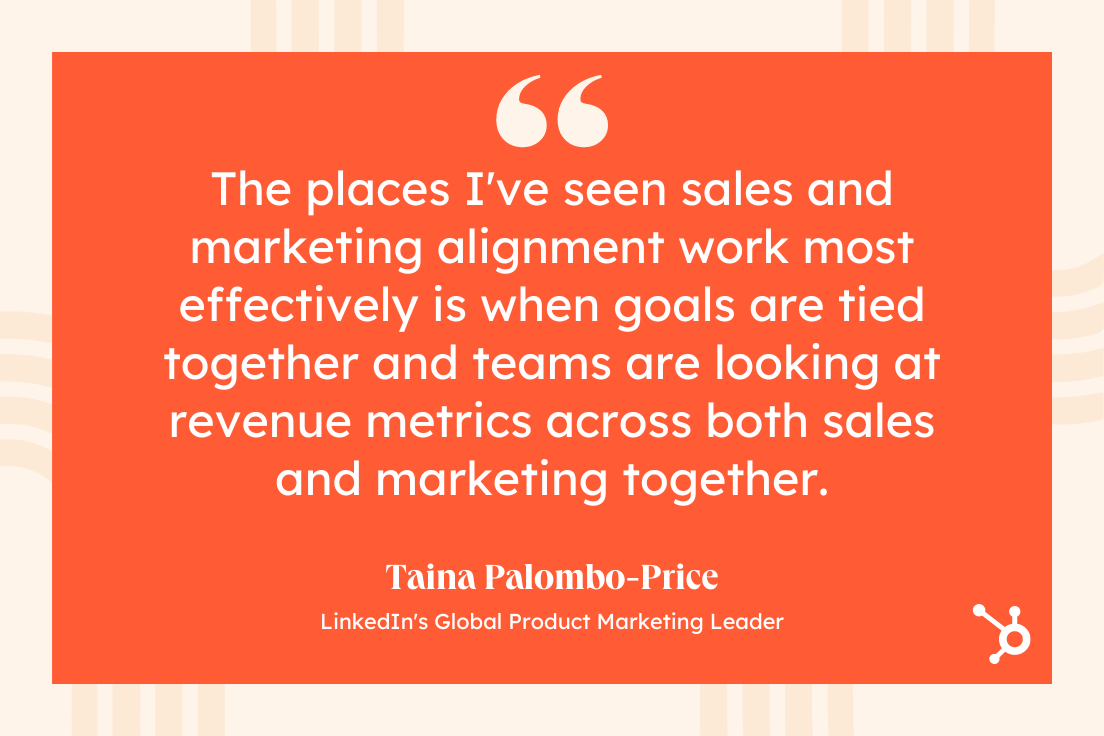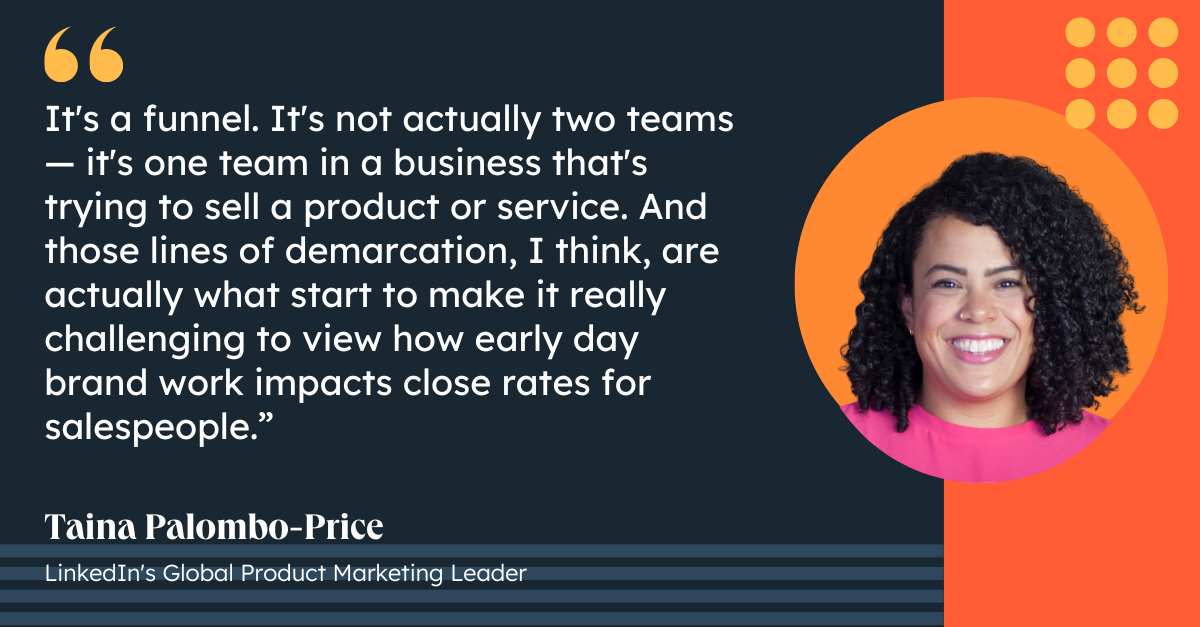Simply put, sales and marketing alignment matters because, while it might seem like they are two separate organizations focusing on separate goals, both teams fall under one go-to-market motion for your business. “You're still one team, even if you're under two leaders, because you're marching towards the same goal — or you should be,” Taina Palombo-Price told me. Nowadays, buyers expect a cohesive, seamless buyer experience — which is an impossible feat if your sales and marketing teams aren't aligned.
1. Create goals that your sales and marketing teams can share.
Oftentimes, marketing teams are goaled on top-of-the-funnel metrics like traffic, leads, or brand awareness. But their job typically ends once they've created a net-new contact or lead for sales.
Sales, on the other hand, is goaled on closing deals and driving revenue.
This separation of goals, Palombo-Price told me, is oftentimes one of the biggest barriers to successful alignment between teams.
“If KPIs are separated instead of unified, that means people are working to satisfy the goals against which they get their paychecks. But the places I've seen sales and marketing alignment work most effectively is when those goals are tied together and teams are looking at revenue metrics across both sales and marketing together,” She says.

Palombo-Price adds, “And then you start to think about it as a funnel that's actually connected, versus a set of disparate tasks that drive one set of KPIs.”
To facilitate stronger alignment, it's vital as a business leader that you take the time to align both organizations under one common metric, like revenue. Each organization can set various KPIs under that one metric, but by laddering each KPI up to one unified goal, both teams can begin speaking the same language when it comes to alignment and performance.
2. Ask your marketing and sales team to create a buyer persona together.
Your marketers have a firm pulse on the consumer — they‘ve conducted extensive research, they’ve engaged with prospects via social media and email, and they've held focus groups.
But, more than likely, your marketers haven't spoken directly to these prospects. They might not fully understand your prospects biggest pain points, or the challenges they face that your product or service currently can't solve. These insights can only be obtained from your sales team.
Ultimately, to get a full picture of your consumer, it's critical that each team help craft the buyer persona. For instance, perhaps you have your marketing team create an initial buyer persona through research and brainstorming sessions — but then you gather input from salespeople to modify and refine that persona.
Getting initial input from salespeople, as well as asking for final approval on a buyer persona, is critical to ensure each team is working together with the same consumer in mind.
3. Ensure marketers know which types of leads sales reps need in any given quarter.
I‘ll admit – as a marketer, I’d never considered that sales reps could be looking for different types of leads in any given quarter based on their current pipeline.
But it makes sense.
As Palombo-Price explains, “Sales teams don't always need the same kind of targeted precision in the conversations they want to have. If their pipeline is full, they're having a lot of high-level conversations and they have a limited need to close big deals in the year. They want to talk to only the buyer who's deeply in-market — who's ready to buy something. And so their threshold is very different than it could be in a moment where you're trying to expand and grow.”
She continues, “It's all about the right types of leads at the right time, and at the right velocity.”
Which leads me to my next point, and a solution to this challenge – regular check-ins between sales and marketing.

4. Set-up regular check-ins between BDRs/SDRs and marketing teams.
One of the most critical roles when it comes to sales and marketing alignment is the BDR (business development rep) or SDR (sales development rep).
BDRs/SDRs focus solely on prospecting and qualifying leads, and pushing them further down the sales funnel — Which is why they're a vital part of sales and marketing alignment.
Palombo-Price told me she encourages bi-weekly or monthly check-ins between BDRs/SDRs and whoever on the marketing side handles lead generation.
As she puts it, “It's important to get into a room and look at, 'What's marketing driving? How does it move through the stages of the funnel? How does it do against lead scoring and the ideal person sales wants to be talking to?'”
She encourages both sales and marketing teams to sit together and consistently monitor how their lead scoring strategy is faring in terms of qualified leads for sales, and how they might continue to refine it.
5. Use those check-ins as a chance to educate both sides.
Once you‘ve organized bi-weekly or monthly check-ins between sales and marketing, you’ll want to ensure both sides are open-minded and eager to learn from the other. If each team plans on blaming the other when leads are unqualified or don't turn into closed deals, these meetings will quickly deteriorate.
As Palombo-Price puts it, “Instead of just being like, 'these leads are all garbage', come to the table and say, 'Hey, we had 15 conversations this week, and six of them were totally off the mark.' And then look at it together.”
She continues, “Because if you don't educate both ways, marketing can't target better. And sales is assuming that the ideal customer profile (ICP) that they've been chasing is always going to be correct. But we know buying groups change.”
Ultimately, there has to be a joint evaluation in which both teams are willing to investigate the aspects of the process that are successful – and the aspects that aren't.
6. Leave functions at the door.
When I asked Palombo-Price the number one tip she'd give any business leader when it comes to sales and marketing alignment, her advice was simple: Leave functions at the door.

She says, “It's a funnel. It's not actually two teams — it's one team in a business that's trying to sell a product or service. And those lines of demarcation, I think, are actually what start to make it really challenging to view how early day brand work impacts close rates for salespeople.”
She continues, “The intent is to try to help draw out some of those through lines so that the impact of the work can be seen on both sides. That's our solution. There's ways you can do it by looking at spreadsheets together in a way that drives that alignment earlier so that those concepts start to stick before you're thinking about how you would leverage those functionalities.”
7. Keep track of every interaction your customer has with your company.
Nowadays, this is one of the most critical strategies you need to implement. It eliminates friction for the customer, and it also helps your sales reps close more deals.
For instance, consider how you‘d feel if you spoke with a sales rep for the first time, and he already knew where you worked, how long you’d been there, which email newsletters you‘d subscribed to, and which company networking events you’d attended. You‘d likely be more impressed than if you spoke to a sales rep who’d never heard of you before, right?
It's vital you find a way to keep track of each interaction your customer has with your company — a CRM is incredibly useful for this. You might also want to check out HubSpot's CRM integration with LinkedIn, which enables LinkedIn Sales Navigator to match LinkedIn's Lead and Account data with the Contacts and Companies objects in HubSpot. (This integration is currently in beta, but you can sign up to receive updates on its launch date.)
Ultimately, understanding the full start-to-finish buyer's journey — and which aspects should be owned by marketing, and which by sales — and creating a culture that encourages transparent and clear communication between sales and marketing will be vital for your organization’s success in 2024 and beyond.
Guest Blogger: Caroline Forsey - Caroline is a seasoned writer and Principal Marketing Manager on HubSpot's Content Growth team. With a degree in English and over 8 years of professional writing experience, she currently oversees thought leadership and partnership content across HubSpot's Marketing, Sales, and Services Blogs, and greatly enjoys combining her interview skills with her passion for storytelling. Prior to her current role, Caroline was the manager of HubSpot's largest property, the Marketing Blog.
Hubspot: https://blog.hubspot.com/marketing/sales-and-marketing






